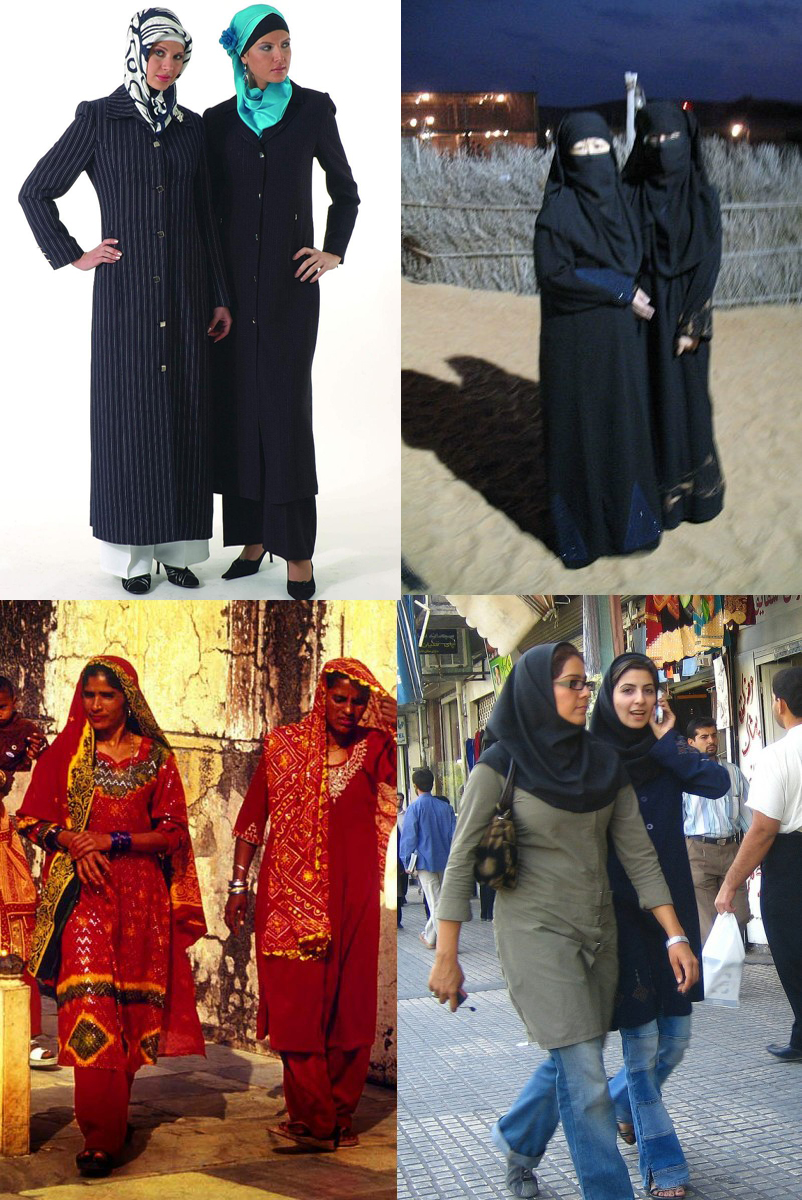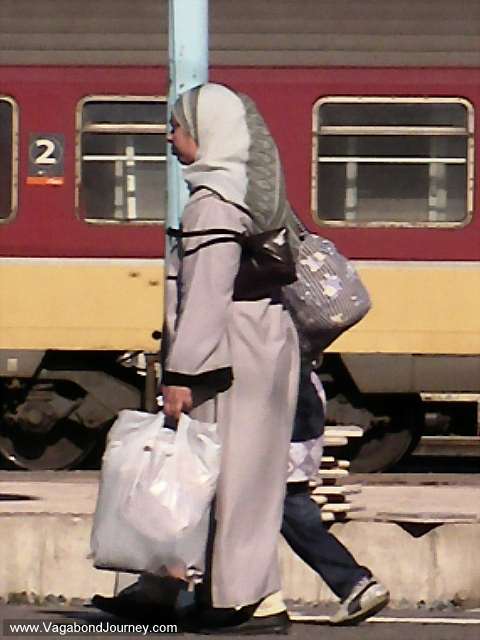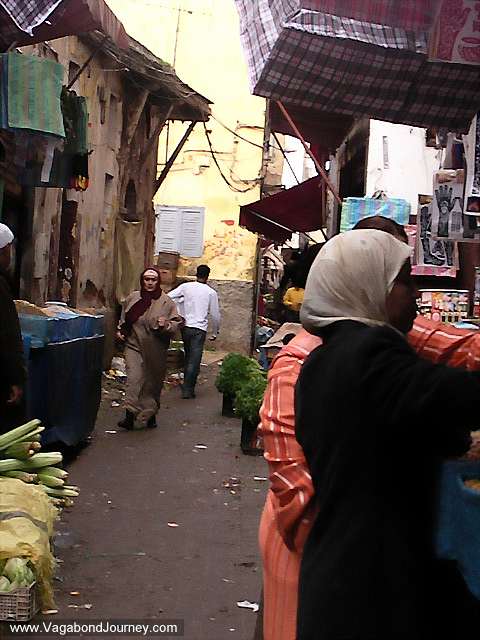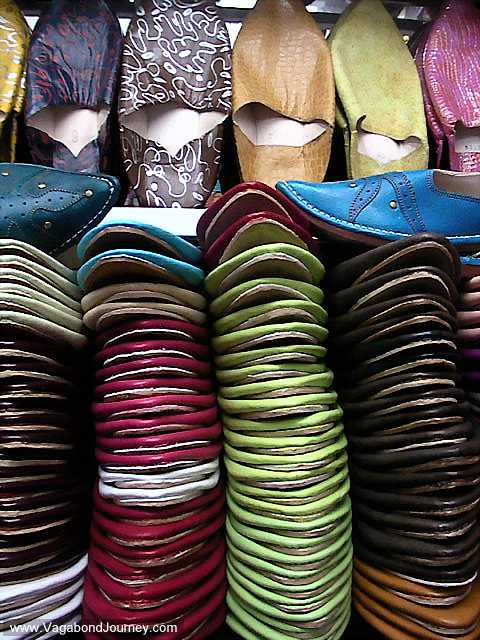Morocco Travel Information
Traditional clothing for women in Morocco consists of brightly colored, long flowing robes, headscarves, slippers, button down blouses, and, sometimes, even veils. This style of clothing has been cultivated since the ancient times of Moroccan history, and is still a part of the living tradition and culture of the country today. Typically, the women of Morocco continue wearing the traditional clothing of their forbearers without extensive variation or influence from the realms of Western fashion, but modern alterations of the historic Muslim-influenced styles of dress are rapidly creeping into wardrobes. Heterogeneous fashions - mixes between traditional Muslim/ Moroccan and modern women's clothing fashions - can now be observed in the streets of Morocco today, but the principles of hijab, the Muslim idea of modest dress, still prevail. There are various different articles of clothing that make up the Moroccan woman's wardrobe, and this paper is meant to shine some light on these pieces, as well as discuss the ways in which Muslim women's fashion has been changing in Morocco.
Hijab and its effect on Moroccan women's fashion:
The idea of hijab - to cover or provide privacy - is a central factor in any discussion of Moroccan women's clothing. "In some Arabic-speaking countries and Western countries, the word hijab primarily refers to women's head and body covering, but in Islamic scholarship, hijab is given the wider meaning of modesty, privacy, and morality" . Thus being, the essential philosophy behind Moroccan women's clothing is to cover the body with clothing which preserve for the wearer an impression of modesty, piety, and highly reserved sexuality. The Qur'an (24:31) states that:
�And say to the believing women that they cast down their looks and guard their private parts and do not display their ornaments except what appears thereof, and let them wear their head-coverings (khimars) over their bosoms (jaybs), and not display their ornaments except to their husbands, their fathers, their husbands' fathers, their sons, their husbands' sons, their brothers or their brothers' sons, or their sisters' sons, or their women, or the slaves whom their right hands possess, or male servants free of physical needs, or small children who have no sense of the shame of sex . . . "
In practice, hijab means that women must keep the essential forms of their womanhood covered from view with clothing that does not provide much of an indication of the shapes and graces found within when in public or in the company of men that are not of their family. This means that the women of Morocco tend to publicly wear long and loose robes (djellaba), button-up blouses which extend down to the knees or the ankles (kafkan), and headscarves (khimar) which cover most of the hair, the ears and the neck. Young girls in Morocco are except from the practice of hijab until the time of puberty, when they too are required to begin donning the concealing clothing of their mothers.
Although hijab - the wearing of modest clothing - is highly regarded in Morocco it is not compulsory for a woman to dress this way. It is becoming fairly common in Morocco for women to go out in public without wearing headscarves, long sleeves, and in Western style clothing. But for formal occasions, such as weddings or religious festivals, the principles of hijab prevail and women tend to wear traditional style Moroccan clothing (Wikipedia).
Examples of hijab mandated Muslim women's fashions are below:

Various examples of hijab throughout the Muslim World. Photo courtesy of Wikipedia Hijab article.
Although the clothing that the Moroccan women are wearing in the above photo appear to be modern or Western, they still sort of conform to the principles of hijab, as the dress is still modest in appearance and cover the entire body.
The base article of clothing that makes up the wardrobe of both Moroccan men and women is the djellaba. This is just a long, loose fitting robe which has a hood attached. The woman's djellaba is usually brightly colored and is ornately stitched with various patterns and/or is beaded. The djellaba generally covers the wearer from head to ankles and, keeping with the principles of hijab, is meant to provide a look of modesty. But the woman's djellaba is becoming adapted to meet with modern fashions and, "are becoming slimmer and shorter" http://en.wikipedia.org/wiki/Djellaba. The traditional women's djellaba can also be considered a jilbab, "which refers to any long and loose-fit coat or garment worn by some Muslim women"
The djellaba's, "hood is of vital importance for both sexes as it protects the wearer from the sun and in earlier times was used as a defense against sand being blown into the wearers face by strong desert winds. It is not uncommon for the hood to be used as an informal pocket during times of nice weather, and can fit loaves of bread or bags of groceries". The hood of the djellaba, which is called a "cob," is also what distinctly defines it from the kaftan, which is simply a button-down cloak that extends to the ankles or, in modern cases, the knees of the wearer that does not have an attached hood.
Examples of the Moroccan woman's djellaba are below:

This is an example of the Moroccan woman's djellaba.

Another photo of women in a market in Casablanca wearing the traditional Moroccan djellaba robe.
An example of a Moroccan woman's djellaba. Notice the hood at the back of the garment.
These are examples of how Moroccan women's clothing is adapted with designs and accessories to be more feminine. Such djellabas as the ones pictured above are very common in Morocco.
The kaftan is another important article of Moroccan women's clothing. It is essentially a long, over-grown, button up shirt which extends to the knees or ankles of the wearer. These garments are worn in the Arab/ Muslim world from Morocco to India, and are part of the standard form of dress for both men and women in these regions. But "In Moroccokaftans are only worn by women, and are substantially different from their Turkish counterpart. They are probably of Turkish origin though, through neighboring Turkish dominated Algeria." The kaftan complies well with the demands of hijab, as they tend to be modest articles of clothing which completely cover a woman's body without giving much sign of what lays beneath
Below are some photographs of kaftans in the Muslim world:
Photo of a Moroccan woman wearing a kaftan in Marrakech.
The above photo is from Wikipedia Morocco Culture and shows an example of an elaborate Moroccan kaftan.
The Headscarf or Khimar:
The headscarf or Khimar is a major part of traditional and modern women's clothing in Morocco. Historically, most women in the country would cover their heads and necks with some type of covering in respect to hijab. But today these issues are not so stringently withheld to, and women in Morocco are free to go in public with or without head and neck coverings.
From my observations based on traveling in Morocco at the end of 2007 and again in the beginning of 2008, many of the young women in the country seem to be taking traditional Islamic dress as the main bearing upon their modern fashions, and retain the headscarf. I was actually surprised at how many women, both young and old, still cover their heads and necks. It seems as if this has much to do with a certain revival in Muslim culture and traditional fashion that is somehow blended into a 'modern' wardrobe.
I have learned that this was not the case twenty years ago in Morocco, when many upper and middle class women were moving away from traditional Islamic clothing and towards more Western fashions. The author, Pamela Windo, writes that, "In the 1980s and 1990s, when I lived in Marrakech, the headscarf was a simple affair. In Gueliz, the New Town, few women wore either a headscarf . . .[but] in 1997 . . . [I] was surprised, alarmed even, to see how many more women are now wearing headscarves, most noticeably in the modern cities of Casablanca and Rabat. Not older women, but young ones; the same age group as the young women who had so exuberantly discarded them a decade before. And instead of scarves tied under the chin, they have now adopted the hijab, which is swathed closely around the head in the stricter Middle Eastern way" (Newsweek, Hijabs and High-heels). This was definitely the case when I was traveling in Morocco, as the headscarf has come back in "style."
Below are photos of Muslim headscarves or Khimar:
Photo of a Moroccan woman in a headscarf while talking on a cell phone in Meknes.
Close-up picture, from the Hijab, of a Muslim woman wearing a headscarf.
Footwear:
The footwear that Moroccans tend to wear are slippers called babouches, and are usually made of soft leather, do not have a heal, and are oftentimes brightly colored. Both women and men in Morocco wear these slippers. The Moroccan slippers that the women wear are usually very decorated and come in many different colors and have a large variety of designs and patterns over them. Many women also wear high-heeled sandals that are often decorated with sparkly finery.
The below photo is of Moroccan women's babouches:

Moroccan women's babouches stacked on top of each other in a market in Marrakech.
The Future of Woman's Clothing in Morocco:
Morocco is a very progressive Muslim culture, and the way of dress for women and hijab is much less strict than in other Islamic countries. There have even been governmental and cultural movements in Morocco to "modernize" the dress code for women in an effort to seem more open to international appeal. In the 1970's and 80's these movements were very popular with the county's upper classes, but today the steam seem to have worn off a little, as "traditional clothing" seems to be very much in style now.
In an article in the BBC's World News website the headline reads, Morocco Moves to Drop Headscarf, and is about how the Moroccan government is slowly removing some images of women in headscarves from school textbooks. But this movement has not yet gone beyond superficial trimmings, as woman's dress is a major issue in Islamic cultures, and any teetering of this balance could provoke a wide-spread fundamentalist movement to counter any government sanctioned changes to women's clothing. But this effort to Westernize women's dress does not seem to have much of an effect on the youth of Morocco, as young women have found ways of combining hijab with modern fashions. As Pamela Windo wrote in an article for Newsweek:
"Although they [headscarves] are made of colorful fabrics with pretty clips at the back, what most struck me was the blatant dichotomy between the hijab and their other clothes. While a few women wear it with a subdued djellaba, and others with their everyday modern suits, skirts and coats, a startling number of young Moroccan women combine the hijab with figure-revealing blue or black jeans, elaborate glittering belts, modern sexy tops and designer sunglasses. Equally striking is the glossy-magazine-style make-up, heavy on the lipstick and black kohl eye-liner" .
This is an interesting phenomenon and is on par with a traditional Islamic revitalization that is taken place throughout the Muslim world. "In more secular Muslim nations, such as Turkey, Iraq, and Egypt, many women are choosing to wear the Hijab, Burqa, Niqab, etc. as an act of defiance against the secularization of society, but also because of the widespread growth of the Islamic revival in those areas[citation needed]. Similarly, increasing numbers of men are abandoning the Western dress of jeans and t-shirts, that dominated places like Egypt 20 to 30 years ago, in favour of more traditional Islamic clothing such as the Galabiyya" . Many young people in these regions seem to be going back on the "modernizing" efforts of their parents and are reveling in their Muslim identity, as least as far as in the way they dress. This can be said of Morocco, as the majority of the young women that I observed in the streets seemed to at least referenced traditional Islamic dress in their clothing, even if the look that they portrayed was overwhelmingly modern.
Photo showing modern dressed Moroccan women.
It is my impression that clothing and style of dress can be used an indication of the ebb and flow of a particular society at a certain point in time. From an analysis of Moroccan women's clothing, I must conclude that the visible manifestations and vestiges of traditional Islamic culture are very strong amongst young women. I can only wonder if this Islamic revival spans beneath the kaftas, babouches, and headscarves." What is considered modest, or daring, in one society may not be considered so in another. It is important, they say, for believers to wear clothing that communicates modesty and reserve in the situations in which they find themselves" . From my observations in Morocco, the clothing of the women seem to very much display the modesty and reserve inherent to the traditional Islamic idea of hijab.
